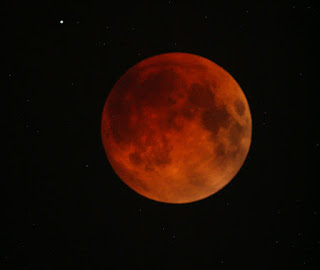Physics Photo of the Week - Special Summer Break Post - May 20, 2022
Total Lunar Eclipse of May 15, 2022 - Photo by Donald Collins
For approximately 1.5 hours on the night between Sunday, May 15 and Monday, May 16, 2022, the Moon appeared dramatically dimmed by being completely immersed in Earth's shadow. Viewing this required staying up late - between 11:30 pm and 1:00 am - way past "prime time". We also see a star visible in the upper left part of the image.
Notice the deep red color of the Moon that usually appears white and bright when full and high in the sky. Why should there be color in the shadow of the Earth when all the light from the Sun is supposedly blocked? The answer may be explained by "leakage" of sunlight through the Earth's atmosphere, similar to seeing the red sky (when not too cloudy) after the Sun has set below the horizon or before rising at dawn. The red sunset is caused by the long path through the Earth's atmosphere (almost tangent to the surface of the Earth) as the rays of sunlight penetrate to the atmosphere above the spot where the ground has curved away into the nighttime side of the Earth. The reddened sunlight has illuminated the air and clouds and is scattered to make the dusk sky still visible - yet highly reddened. A man on the moon (if an astronaut) were to look back at the Earth during such an event, the appearance of the night side of the Earth would be mostly dark (possible city lights visible), but the ring of the Earth's atmosphere would be glowing red. The Sun would be "set" below the horizon and the atmosphere visible to the astronaut on the Moon as a bright thin, red ring surrounding the Earth. That diffuse light reaches the lunar surface to illuminate it.
During the manned lunar missions, no missions were planned to occur during a lunar eclipse. The rapid temperature extremes resulting from the abrupt change from bright direct sunlight (extremely hot on the Moon) to extreme cold during the extended stay (1 1/2 hours) in Earth's shadow. Manned lunar missions have never visited the Moon when full either because the intensity of the sunlight would be much greater than the usual times of lunar missions when the Sun was low to the Lunar horizon (partial phase as viewed from Earth).
Here is a picture of the partial eclipse as the Moon was partway into Earth's shadow at about 11:00 pm (30 minutes before totality). In this image, we can clearly see the curvature of the Earth as the edge of the deep shadow. The Moon has immersed about half its diameter into Earth's shadow. The illuminated part of the Moon's surface is the usual grey color as contrasted to the deep red appearance of the totally-eclipsed Moon. However upon close inspection of the bright part we can see the brightness gradually diminish as the surface is closer to the deep shadow. All of the illuminated part of the Moon lies in a partial shadow: the appearance of the Sun would be in a partial eclipse by the Earth if the astronaut were to view the Sun through protective equipment. For astronauts closer to the shadow's edge the Sun would be more and more eclipsed by the Earth. Astronauts within the fully dark shadow would view the totally-eclipsed Earth with the red ring of the Earth's atmosphere as discussed above.
The Earth's shadow on the Moon is a relatively rare occurrence. At any particular place on Earth, we get to witness a lunar eclipse only once in 2-3 years. In contrast the partial phases (crescent, half, gibbous, full, ...) cycle every month ("month" = "moon"). Such monthly appearances of crescent moon are caused by seeing the Moon's own shadow, distinguishing the lunar daytime from lunar night. During the crescent moon phase, the Sun is mostly on the far side of the Moon, and we are viewing the dark side of the Moon that is mostly facing the Earth. During the half-moon phase (called a "quarter phase" for 1/4 of the month) the moon appears as a half illuminated "disk" in which the light/dark "terminator" forms a straight line across the vertical diameter of the Moon, not curved by the curvature of the Earth's shadow as in the photo of the partial eclipse.
I decided (with a friend) to publish the lunar eclipse during the summer break and hiatus of PPOW on account of the timely nature of the event. I plan to publish a follow-up discussion during the regular season of PPOW this fall explaining some more interesting aspects of the May 2022 lunar eclipse.
Physics Photo of the Week is published weekly during the academic year on Fridays by the Warren Wilson College Physics Department. These photos feature interesting phenomena in the world around us. Students, faculty, and others are invited to submit digital (or film) photographs for publication and explanation. Atmospheric phenomena are especially welcome. Please send any photos to dcollins@warren-wilson.edu.
All photos and discussions are copyright by Donald Collins or by the person credited for the photo and/or discussion. These photos and discussions may be used for private individual use or educational use. Any commercial use without written permission of the photoprovider is forbidden.





Comments
Post a Comment